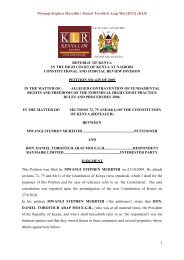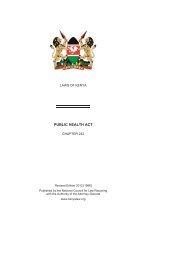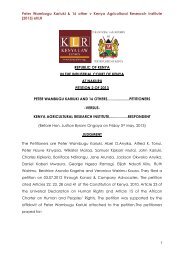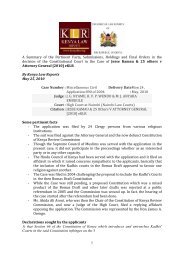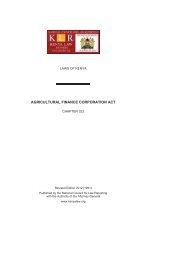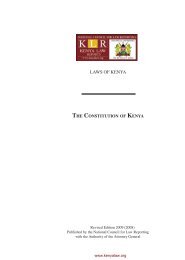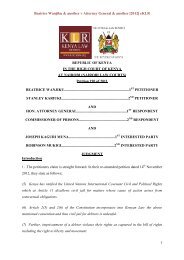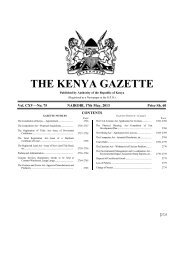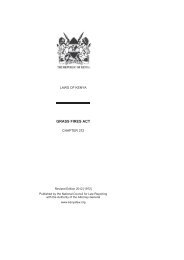Download Case - Kenya Law Reports
Download Case - Kenya Law Reports
Download Case - Kenya Law Reports
You also want an ePaper? Increase the reach of your titles
YUMPU automatically turns print PDFs into web optimized ePapers that Google loves.
Omar Said Omar v Republic [2008] eKLRREPUBLIC OF KENYAIN THE HIGH COURT OF KENYAAT NAIROBI (NAIROBI LAW COURTS)OMAR SAID OMAR aliasCriminal Appeal 169 of 2006AHMED ALI MOHAMED..………….………..…. APPELLANT-AND-REPUBLIC………………………………………...RESPONDENT(An Appeal from the Judgement of Senior Principal Magistrate Mrs. R.A. Mutoka dated 4 thApril, 2006 in Criminal <strong>Case</strong> No. 1274 of 2005 at Nairobi <strong>Law</strong> Courts)1. FIVE CRIMINAL CHARGESJUDGEMENTOmar Said Omar Ahmed alias Ahmed Ali Mohamed was charged, in the first count, with theoffence of being in possession of firearms contrary to s.89(1) of the Penal Code (Cap. 63,<strong>Law</strong>s of <strong>Kenya</strong>).The particulars in the first count were that the appellant jointly with others not before theCourt, on 11 th August, 2003 in the Ziwani area, in Mombasa District within Coast Province,had in their possession, without reasonable excuse, five light anti-tank weapons, serial Nos.EE057, HED 51201, AE 263205, BE 33-2706 and BE 33-0149 in circumstances which raisedreasonable presumption that the said firearm was intended to be used in a manner prejudicialto public order.To the first count, there was an alternative charge: being in possession of a firearm without afirearm certificate contrary to s.4(1) as read with s.4(3) of the Firearms Act (Cap. 114, <strong>Law</strong>s1
Omar Said Omar v Republic [2008] eKLRof <strong>Kenya</strong>). And the particulars were that the appellant, jointly with others not before theCourt, was found, on 11 th August, 2003 in the Ziwani area of Mombasa District aforesaid, inpossession of five light anti-tank weapons, of the serial numbers aforementioned, without afirearm certificate.The appellant was charged in a second count, with an offence identical to that in count 1,though the particulars were different: that he, on the same date and in the same area, had inhis possession, without any reasonable excuse, one hand grenade, S.No. 93PL – 61, anexplosive, in circumstances which raised the reasonable presumption that the said explosivewas intended to be used in a manner prejudicial to public order.There was an alternative charge to this count: being in possession of ammunition without afirearm certificate contrary to s.4(1) as read with s.4(3) of the Firearms Act. And theparticulars were that at the same place and on even date, the appellant jointly with others notbefore the Court, was found in possession of the explosive aforementioned, withoutreasonable excuse, and without a firearm certificate.The appellant was charged, in count 3, with the offence of being in possession of ammunitionwithout a firearm certificate contrary to s.4(1) as read with s.4(3) of the Firearms Act. Theparticulars were that the appellant, jointly with others not before the Court, was found on thedate and place aforementioned, in possession of 177 rounds of ammunition of 762 mm.calibre, without a firearm certificate.In count 4 the appellant was charged with the offence of making a document without authoritycontrary to s.357(a) of the Penal Code. The particulars were that the appellant, on or before29 th August, 2000 at Mombasa, with intent to deceive, and without lawful authority, made acertain document, namely a national identity card, S.No. 23869938 in the name of Ahmed AliMohammed purporting to be a national identity card issued by the National RegistrationBureau.The appellant faced a fifth charge, of uttering a false document contrary to s.353 of the PenalCode. The particulars were that the appellant, on or about 26 th June, 2003 at Mombasa,knowingly and fraudulently, uttered a certain forged identity card (of the serial numberaforementioned) to Justus Mwadime purporting to be a photocopy of a genuine identity cardissued by the National Registration Bureau.2. FINDINGS AND ORDERS OF THE TRIAL COURT2
Omar Said Omar v Republic [2008] eKLRAfter hearing 16 prosecution witnesses, a number of them on first testimony and then onrecall, and the unsworn defence statement, and after considering the submissions of counselon both sides, the learned Magistrate conducted an analysis of the evidence, which led her tothe findings that –(i) charges in counts 1, 2 and 3 had been proved beyond reasonable doubt;(ii) the charge in count 5 was not proved – and consequently, acquittal ordered on this count.The learned Magistrate found that:“Given the fact that the accused person concealed his identity when he rented his flat, and[taking into account] the circumstances surrounding his arrest and the recovery of the firearmsfrom his house, I must reach the conclusion that he was in possession of the firearms in equalmeasure as Faisal [who killed himself in a self-detonated explosion] and the third, unknowntenant. It is not conceivable that these firearms were ferried into that flat after the arrest of theaccused, because PW2, PW3 and PW5 have stated that it [the flat] only had three tenants whoceased living [therein] all at once. So even though on 11 th August, 2003 the accused personwas not in actual possession of the weapons and ammunition, he certainly was in constructivepossession of the same, and I find that the prosecution has proved possession as set out incounts 1, 2 and 3 [of the charge]”.On the three charges, the trial Court convicted the appellant, and imposed sentence aftertaking into account the mitigation statement, as well as the fact that he had remained incustody since August, 2003. The sentence imposed was eight years’ imprisonment for eachcount, to run concurrently.3. APPEAL AGAINST CONVICTION AND SENTENCEIn the amended petition of appeal dated 12 th October, 2007 and filed on 29 th October, 2007the appellant stated, in summary, as follows:(i) That the charges as stated in the charge sheet, for counts 1, 2 and 3 were defective; theevidence did not support these charges; proof-beyond-reasonable-doubt was not achieved;(ii) That there were discrepancies of dates and places, in relation to the allegedcommission of the offence;(iii) That the appellant had been under arrest well before the commission of the offence –and he was thus wrongly associated with the offence;3
Omar Said Omar v Republic [2008] eKLR(iv) That there had been a violation of the appellant’s trial rights under s.72(3) of theConstitution – because he was arrested on 1 st August, 2003 but charged only two years later,on 16 th October, 2005;(v) That nothing mentioned in the charge sheet had been found in the possession of theappellant.(vi)That on 1 st September, 2005 the coram was not properly entered on the Court record.(vii) That when the presiding Magistrate took over the case she had not complied with theterms of s.200(3) of the Criminal Procedure Code (Cap.75, <strong>Law</strong>s of <strong>Kenya</strong>) which requiredthat the appellant be informed of his rights;(viii)terms;(ix)That the trial Court erred, by not granting the appellant reasonably affordable bailThat the trial Court convicted “on very poor evidence on identification”;(x)That the trial Court had relied on contradictory evidence, to reach conviction;(xi) That the identification parade, the evidence from which the trial Court accepted, wasflawed;(xii) That the trial Court failed to find that the appellant’s identification card was not foundin the area where the firearms the subject of the charges, were found;(xiii)That the trial Court erred by convicting merely on the basis of suspicion;(xiv) That the trial Court failed to find that the key witness had seen the appellant somefour-to-five days before 11 th August, 2003 when the locus in quo was raided by the Police;(xv) That key witnesses, PW2, PW3, PW4, PW5 and PW8 had given descriptions ofsuspects which did not coincide with the appellant’s appearance;(xvi) That there was no proper inventory of physical evidence that provided circumstancesconsistent with identification of the appellant as a suspect.4
Omar Said Omar v Republic [2008] eKLRLearned appellant’s counsel, Ms. Odembo contended that the charge sheet was defective,because it had mixed up two Mombasa locations in its reference – Ziwani, and Sparki; and theevidence tendered supported recovery of firearms at Sparki and not Ziwani.Ms. Odembo urged that the appellant had been held in custody from 1 st August, 2003 andwas only arraigned in Court on 10 th June, 2005; and there was no explanation on the recordfor the two-year delay in charging him. On this basis, learned counsel submitted that the trialwas a nullity from the beginning.In this regard counsel relied on the provisions of s.72(3) of the Constitution, and cited theCourt of Appeal decision in Gerald Macharia Githuku v. Republic, Crim. App. No.119 of2004. She submitted that the prosecution were in breach of s.72(3) of the Constitution, and sothe trial should be declared a nullity.Ms. Odembo urged that the charges relating to fire-arm certificate could not stand: becausethe explosives and ammunition referred to in these charges, were not produced in Court asexhibits.Counsel urged that the arresting officer, who said he arrested the appellant on 1 st August, 2003had said “he arrested the accused with nothing in his possession.” And so, counsel urged, thecharge could not stand; and this was so, particularly, because the date of storming the locus inquo, when the firearms were recovered, was in the future – on 11 th August, 2003. Counselreferred to this date as the crucial date, “the date of commission of the offence, according tothe charge sheet.” Since the appellant had been arrested earlier, Ms. Odembo urged, “he wasnot in possession.”Learned counsel contested the trial Court’s proceedings also, on the basis that the record ofcoram was improper; although it was recorded that Mr. Okello was representing the State, hisdesignation was not shown, and so he could well have been an unqualified prosecutor, in theterms of the law.Ms. Odembo next took on the issue of language used in Court. She stated that in theproceedings, on a certain date, 13 th June, 2005 it was not recorded what language was used inCourt; and she urged that on this account, the trial proceedings be nullified. Counsel called in5
Omar Said Omar v Republic [2008] eKLRaid the Court of Appeal’s decision, Jackson Leskei v. Republic, Criminal Appeal No. 313 of2005, and cited the following passage in that case:“In the matter before us, while, by inference, we think that the appellant was possibly allowedthe services of an interpreter, in [the] absence of a note to that effect, we entertain a doubtthat that was so. It is a matter which has caused us much anxiety, more so considering thatthe appellant has a sentence of death hanging over his head. This and several other cases wehave handled before, show the grave danger inherent in the failure by the trial Court torecord the essential details in proceedings before it: the name of the officer trying the case;the prosecutor and his rank; the court interpreter or clerk, and the language or languages ofthe proceedings; the language used by each witness; that judgement was pronounced; thedate thereof, and in whose presence, etcetera. These are as important as the evidence andform part of the fair process of justice, the omission of which might affect an otherwise soundconviction.”Counsel submitted that the coram details were incomplete, on 27 th June, 2005 – and she urgedthat the appeal be allowed, on that account. Coram, she urged, was incomplete on thatoccasion because the rank of Mr. Okello the prosecutor, was not shown on the record.Counsel then contested an aspect of the prosecution evidence: PW2 who lived at Sparki hadsaid he was a neighbour of the appellant. But the explosives which are the subject of thecharge were said to have been found at Ziwani. This, counsel urged, went to cast doubts onthe claim that the appellant had been found in possession of the firearms.Counsel submitted that PW2 was not a truthful witness; because he had said that several days(4-5 days) prior to the storming of the locus in quo on 11 th August, 2003, he had seen threeneighbours including the appellant – yet the appellant had been arrested on 1 st August, 2003and transferred to Nairobi, several hundred kilometres away.The words of PW2 as recorded in the proceedings may be set out here:“I am Hassan Ali Ahmed. I am a transporter. I live at Sparki Majengo Ya Simba area inMombasa... [On]... 11 th August, 2003, a Sunday night leading to Monday morning – at about2.00 a.m., I was [awakened] by the door bell... I looked out and saw two army officers. My6
Omar Said Omar v Republic [2008] eKLRmother opened, and the army officers [entered] and searched our house. We then wentupstairs, and they knocked on the first door and it was opened. They went to the 2 nd door onthe same floor and knocked... but no one opened. They broke the door and entered, and so didI. I saw a computer and a sofa set in that flat. I saw the three-seater being turned upsidedown and, from under it, I saw these [he identifies anti-tank missiles] ...The occupants of thathouse moved into it one month after we [moved into our flat]. We moved in on 15 th July,2005. I never saw the occupants move in, but I saw three people who lived in there. Laterafter two days from the storming-in, Police officers showed me many photographs. I was ableto identify this man...This photograph bears the picture of one of them..I saw him leave theflat twice..I never talked to them. I never saw any person other than the three enter that flat.”Of PW2, certain questions were asked in cross-examination. His response, in part, was asfollows:“Police asked me the appearance of [those] people, and I told them they looked like Arabs. Itold the Police their apparent ages were between 20 – 25 and 24 – 30 years. The flat was onthe top floor. I lived on 1 st floor..I told the Police that sometimes they wore caps, and alwayslooked down; they never talked to anyone but the deceased [Feisal] greeted me one. I did notknow their names. The last time I saw them was about 4 – 5 days before the Police stormedtheir house. I saw two – one was the deceased, and the other is not in Court. I told the Policethat on 5 th August, 2003 I saw the three. It was about 5.00 pm...I was at the balcony and I sawthem leave their house and disappear.”It was Ms. Odembo’s submission that PW2 had not identified the appellant herein as one ofthe three suspects who were his neighbours at the apartment-block.Ms. Odembo also submitted that whereas the criminal case was at first presided over by ChiefMagistrate Mr. A. Muchelule, it subsequently came before Senior Principal Magistrate Mrs.R.A. Mutoka, but without information being given to the appellant herein, as required bys.200(3) of the Criminal Procedure Code. Counsel submitted that, before Mrs. Mutoka, thecharges should have been read afresh to the appellant herein, before PW1 took the witnessstand.7
Omar Said Omar v Republic [2008] eKLRLearned counsel urged that it was by mistaken identity, that the appellant had been arrestedand charged. She urged that this is a typical case in which visual identification was mistaken;and she relied on the Court of Appeal decision in Joseph Ngumbao Nzavo v. Republic (1991)2 K.A.R. 212 where the following holdings are set out:“Before accepting visual identification as a basis of conviction the Court had a duty to warnitself of the inherent dangers of such evidence.“A careful direction regarding the conditions prevailing at the time of the identificationand the length of time for which the witness had the accused person under observation,together with the need to exclude the possibility of error, was essential.”Counsel urged that PW3, though she lived in the same apartment-block as the three suspects,had seen them only once; and so she could not be a reliable identifying witness.Counsel submitted that another neighbour of the appellant, PW5 (Veronica Kamau) had alsonot been able to identify the appellant herein. The relevant words of this witness are asfollows:“In early July [2003] the flat next to us was occupied. I never saw them when they movedin but towards the end of July, the watchman called me to go downstairs saying the landlordwanted to see all tenants...The landlord sent the watchman to call the occupants of the flatnext to mine. I saw a young man come to the 1 st floor flat, and that is when I saw him. I nextsaw him in August when he was on TV and I saw he was injured and was struggling, and Irecognised him... I was shown two photographs and was able to identify one young man whoI saw at the 1 st floor....”Identification ParadeMs. Odembo questioned the propriety of the identification parade at which the appellant wasidentified, from the standpoint of compliance with the Police Force Standing Orders onidentification parades. She urged that the identification parade which was conducted byPW13 on 22 nd August, 2003 was in respect of a murder charge – not a charge in respect ofpossession of firearms. The parade, counsel urged, was flawed, because the appellant was notphysically touched by the identifying witnesses.8
Omar Said Omar v Republic [2008] eKLRPW13 gave testimony on the manner in which the parade was conducted:“For security [reasons] the witnesses were kept in the offices [where I was]. Theidentification parade members and the suspect [were] outside. When you are in that office,you can see outside but those outside cannot see inside. The barrier is glass..After I filled [in]the forms the suspect was brought to where the other parade members were. I lined up theparade members and asked the suspect where he wanted to stand. The parade members were7. He chose to stand between no. 4 and no.5. I then communicated with the investigatingofficer to bring out a witness, Veronica Kamau. She was not able to identify the suspect....Iasked for the 2 nd witness, one Kassim Salma, and he was able to identify the suspect. I wascommunicating with the witness on phone, asking if he or she could pick out anyone, and thewitness would say the number or position of the suspect. I went and told the suspect that hewas identified, and he made no comment. I then called for the 3 rd witness, Abdalla Ali, but hewas unable to identify the suspect. I called for witness no.4, and told him to look through theline of men and see if he could identify the suspect..He identified the suspect. I asked forwitness no.5 – one Lucy Kamau...[She] did not identify the suspect...”The questionable aspects of the identification parade, foreshadowed by learned counselMs. Odembo, became more obvious during cross-examination. The following answer givenby the parade officer (PW13) may be noted:“...at part A [of the form] the offence is indicated as murder. The investigating officer told methe same... I asked the suspect if he was ready to participate in the identificationparade...and he said yes. If he had refused, I would not have forced him. ...I talked to theaccused about the identification parade. I had seven members of the parade. I never selectedthem. It is the investigating officer who did so. It is my duty as parade officer to do so, butthey were properly chosen and they looked alike...In some circumstances an identificationparade can be conducted by phone. I never dated the certificate but at the top it is recordedthat it was on 22 nd August, 2003... The investigating officer did not participate in the parade.He was in the room with the witnesses. If [he] was pointing out the suspect to the witnesses,then all the witnesses could have identified him... For security reasons the witnesses couldnot touch the suspect...The witnesses never told me that they feared for [their safety].”9
Omar Said Omar v Republic [2008] eKLRBy para.6 of the Identification Parade Standing Orders it is provided that: the accused orsuspect is to be informed of the reason for the parade; the responsible Police officer is not toconduct the parade; witnesses are not to see the accused or suspect, before the parade; thereare to be at least eight parade members – of striking similarity to the suspect; witnesses arenot to communicate with one another, pending completion of the parade; unauthorisedpersons are to be excluded from the parade; the witness “actually touches the person he [orshe] identifies”; “a careful note must be made after such witness leaves the parade, to recordwhether he identified the accused/suspect, and in what circumstances”; “the parade must beconducted with scrupulous fairness, otherwise the value of the identifications as evidence willbe lessened or nullified.”Counsel drew the Court’s attention to the Court of Appeal decision in David Mwita Wanja& Two Others v. Republic, Crim. App. No. 117 of 2005, in which the following passage, inrelation to identification-parade procedures, appears:“The purpose for, and the manner in which, identification parades ought to be conductedhave been the subject-matter of many decisions of this Court over the years and it is worryingthat officers who are charged with the task of criminal investigations do not appear to get itright. As long ago as 1936, the predecessor of this Court emphasised that the value ofidentification as evidence would depreciate considerably unless an identification parade washeld with scrupulous fairness and in accordance with the instructions contained in [the]Police Force Standing Orders.”Mrs. Odembo submitted that the identification parade conducted by PW13 was a nullity for,inter alia, having seven parade members, rather than a minimum of eight. Counsel noted thatit was remarkable that even close neighbours of the appellant, during the parade, failed toidentify him. Counsel noted that the witnesses who appeared at the parade had previouslybeen shown photographs of the persons they were to identify; and when they identified, theydid so by informal indications at some distance from the yard where the parade membersstood.Trial Rights under ss.72(3) & 77 of the Constitution10
Omar Said Omar v Republic [2008] eKLRLearned counsel urged that the appellant’s trial-rights under s.77(1) of the Constitution (whichrelate to fair trial within reasonable time) had been violated, as it took two years to lay thecharge – and this was not a reasonable length of time. Counsel urged that there had been nobasis in the first place, for bringing the charge, as an Investigating Officer, Senior AssistantCommissioner of Police, Obadia Kariuki Kimani (PW1) had stated on cross-examination, on30 th August, 2005, that:“Accused was arrested as a suspicious character who could be involved in the terrorist attackat Kikambala.”Counsel urged that there was no direct evidence to link the appellant to the offence; for thewitness had not called as a witness the person who gave him the information implicating theappellant and which he had relied upon.Learned counsel submitted that there was no evidence on record linking the appellant tothe offences charged.4. CONTESTING THE APPEAL: THE POSITION OF THE STATE(a)Technical and Procedural MattersLearned respondent’s counsel, Ms. Nyamosi, however, contested the appeal, and expressedher support for both conviction and sentence. She, first, remarked that the technicalobjections on the recording of coram, cannot stand, because the dates in reference were onlymention-dates, purely concerned with administrative issues, and not involving a hearing ofany matter of merit. And on the question of the rank of the prosecutor, counsel drew theCourt’s attention to the record on p.12 of the typed proceedings, which described Mr. Okelloby his designation, as State Counsel – an officer eminently qualified to conduct prosecutions.On the question of language used in Court, learned counsel urged that there was nothingirregular in the proceedings, as it was shown that Kiswahili/English were used in Court; andbesides the appellant herein had been represented all along by an advocate, Mr. Ngaira.As to the correctness of the charge sheet, especially in relation to the location of the locusin quo, counsel urged that it was plain from the evidence, especially that of PW5, that both11
Omar Said Omar v Republic [2008] eKLRSparki and Ziwani in Mombasa were located in one general area; and the fact that the trialCourt had visited the scene, strongly suggested that alternating reference to Sparki andZiwani, would have caused no prejudice to the appellant. Should such minor differences beseen as significant, counsel urged, then they may be cured by virtue of s.382 of the CriminalProcedure Code (Cap. 75, <strong>Law</strong>s of <strong>Kenya</strong>).On the question whether the appellant was arrested on 1 st August, 2003, more than a weekbefore the locus in quo was stormed by the Police on 11 th August, 2003, Ms. Nyamosisuggested that there could be a confusion of dates – though she urged that any such confusiondid not prejudice the appellant, for the appellant did understand what the witnesses weretestifying about.On the question whether there had been compliance, in the conduct of proceedings, withs.200(3) of the Criminal Procedure Code, counsel submitted that there was no irregularity –especially for the reason that Senior Principal Magistrate Mrs. Mutoka had taken all theevidence, from PW1 to PW16; she also heard the defence case; and she wrote and deliveredjudgement; “at no point did any other Magistrate take over from her, and so s.200(3) was notrelevant.”On the foregoing technical and procedural points, learned counsel Ms. Nyamosi haseffectively addressed several of the grounds of appeal, and the position she has urged, as Ifind and hold, is to be sustained. In effect then, the appeal must stand or fall on the severalissues of merit which learned counsel Ms. Odembo raised.(b)Questions of MeritIdentification ParadeMs. Nyamosi conceded that the identification parade, at which witnesses are said to haveidentified the appellant herein as a suspect, was flawed – because the parade members wereseven and not eight.Counsel went on to urge, however, that such a defect in the trial was severable, and wouldleave the proceedings, the judgement, the conviction and sentence still standing, and to beupheld. In Ms. Nyamosi’s words:12
Omar Said Omar v Republic [2008] eKLR“...there was no need for an identification parade to be conducted. There is evidence fromwitnesses who recognised the appellant. The evidence of identification on an identificationparade was not necessary.”Is it for Certain the Appellant was in Possession of Firearms?Learned counsel urged that there was evidence on record, showing that firearms andammunition were recovered – and that this was clear and consistent evidence from Policeofficers who went to the scene; this evidence was confirmed by the scenes-of-crime officer(PW11); PW11 took photographs of things recovered from the house which the appellant wassaid to have rented; the prosecution proved that the firearms and ammunition were, indeed,recovered.Counsel submitted that the prosecution only needed to further prove that the itemsaforementioned were in the possession of the appellant; and it was proved that they were inthe constructive possession of the appellant; they were recovered from the house where theappellant had been living.Counsel focussed this submission especially on the testimony of Justus Mwadime(PW14). The evidence of this witness may, therefore, be considered in some detail.PW14, Justus Mwanyolo Mwadime is in the real property business, and runs a firm by thename Justhand Properties. PW14 frequently gets property-leasing contracts from Kassim Ali(PW8), a landlord. One of PW8’s blocks of apartments is located at Sparki, in the MwembeTayari area of Mombasa.In June & July, 2003, PW8 asked PW14 to find a tenant for a two-bedroom apartment atthe Sparki block of flats. After putting up advertisements, PW14 found a tenant for PW8, inJune 2003; and he thereafter introduced the tenant to the landlord. PW14 negotiated the termsof tenancy, and the following day, the tenant paid the required rent. The tenant produced hisoriginal identity card, and PW14 photocopied it and returned the original to its owner. Thetenant was with PW14 for only five minutes, and “that was the only time [PW14] saw him.”PW14 had recorded a statement with the Police, in which he said he “could not recall thenames of the tenant.” Although PW14 thought the names of the tenant would be shown in the13
Omar Said Omar v Republic [2008] eKLRlease agreement, when he was recalled to testify, and he had a chance to view the originallease agreement, he now said:“It was not signed because I never met the tenant after our first meeting...”From such a state of the evidence, it is clear that PW14 did not have very much informationabout the tenant, even though learned counsel Ms. Nyamosi set store by his contribution to thetestimonies.It is, in my perception, a rather feeble basis of identification: but learned counsel reliedupon it to build the “possession thesis”, that –“Even if the appellant was not found with the items, he was the owner in possession of thehouse; he was constructively in possession.”From that foundation, counsel came to the conclusion that:“The judgement of the Magistrate properly evaluated the prosecution case with every detail;she took into account all anomalies; and she took into account the unsworn evidence by theappellant. She came to the right conclusion when she convicted.”5. FINAL ASSESSMENTIt falls to this Court to decide one crucial question: was the appellant rightly convicted for theseveral offences charged? I have already considered the formal challenges to the integrity ofthe trial; but I have found them adequately answered by learned counsel Ms. Nyamosi. If Ifind, on the merits, that the appellant was wrongly convicted, then I must acquit him.On the merits, the main question is whether the prosecution proved their case beyondreasonable doubt. The Police investigators, apparently, did find dangerous explosives andfirearms in a certain house, at Sparki in the Mombasa area. It was the duty of the Police totrace accurately the person who was in possession of the said firearms and explosives. Thelearned Magistrate held that the person in possession of the items was the appellant herein.But, is that the true position? The answer depends on identification. Although counsel hascontended that the appellant could be linked to the illicit items even through recognition, I do14
Omar Said Omar v Republic [2008] eKLRnot believe it. None of the witnesses, including the property-agent who leased the flat thatwas the locus in quo, recognised the appellant as the person he had dealt with. “Neighbours”living in the same block of flats, had not at all recognised the three persons claimed to havebeen tenants in the said block of apartments.After ruling out recognition, I must also rule out any possibility that a witness properlyidentified the appellant herein as a person connected with the illicit items. It has caused meanxiety that the Police officers involved in the investigation had laboured so much to give theappearance that the appellant herein had been identified as a suspect; and the charade that wasthe identification parade conducted by Chief Inspector of Police Susan Njeri (PW13) isparticularly relevant on this point. It was an identification parade conducted in breach of thePolice Standing Orders, and a parade that was grossly unfair to the appellant herein.Clearly, no witness has squarely linked the appellant to the special ownership (of tenancy)of the flat that was the locus in quo; and it follows that it would have been wrong, as a matterof fact, to apply the doctrine of constructive possession, to link the appellant to the firearmsand explosives which were said to have been recovered.The foregoing conclusion is, in my opinion, strengthened by the fact, as emerges from theevidence, that as at 1 st August, 2003 the appellant had been arrested and carted off toNairobi; whereas the flat that was the locus in quo was being stormed by the Police abouteight days later. If the identity of the true tenant of the said flat had not been established byevidence, the uncertainty, which must, as a matter of law, be taken in the subject’s favour, isdeepened by the failure to account for the goings-on at the said flat during the eight days sincethe appellant had been taken away from Mombasa.The picture emerging from the quality of prosecution evidence, and from the restlessmotions of Police officers in their preoccupation with the appellant, is that of an overzealousnesswhich was not attended with professional-investigation methods. The burden ofall this heavily fell on the appellant, who, consequently, did suffer prejudice.No explanation was proffered for the interminable period of two years, during which theappellant was held before being arraigned in Court. It was a violation of his constitutionalrights under s.72(3) and s.77 of the Constitution, just as learned counsel urged.15
Omar Said Omar v Republic [2008] eKLR6. FINAL DETERMINATIONS AND ORDERSThe foregoing analysis of the evidence has led to conclusions on points of law and fact, whichwarrant certain declarations and orders:(i) The appellant’s appeal is allowed; conviction on all the three counts is set aside; sentenceis quashed.(ii) The appellant shall be set at liberty forthwith, unless he is otherwise lawfully held.(iii) It is declared that the conduct of the Police authorities in connection with the arrestand detention of the appellant, was in violation of the appellant’s rights as safeguarded insections 72 and 77 of the Constitution of <strong>Kenya</strong>.Orders accordingly.DATED and DELIVERED at Nairobi this 16 th day of September, 2008.J.B. OJWANGJUDGECoram: Ojwang, J.Court Clerk: HukaFor the Appellant: Ms. OdemboFor the Respondent: Ms. Nyamosi16



